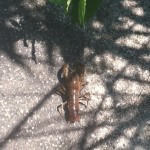Recently, prairie volunteer Greg Jerzyk captured a rare sight with his camera on the prairie–a tower crayfish! Many people don’t know that a prairie contains such creatures. It speaks to the incredible complexity of this now extremely rare and endangered ecosystem. Below is a first time digital reprint of STPS Director Rita McCabe’s article about prairie crayfish. We hope you enjoy!
- Tower Crayfish – Photo by Greg Jerzyk –Click to Enlarge
Prairie Crayfish ( Procambarus gracilis )
Few people who study prairies ever claim to be prairie experts. Years of observation have taught them that the prairie’s complexity is slowly revealed over extended periods of time by close, recorded observations of its flora and fauna as well as through studies of their complex interconnectedness. A good example of this interconnectedness can readily be seen by a close look at Procambarus gracilis, a seldom seen prairie denizen, who nevertheless benefits his habitat.
Since crayfish must keep their gills hydrated, they are usually associated with streams, rivers, and lakes. While it is true that Wolf Road Prairie has wetlands, it is also true that in many years the wetlands shrink or dry by midsummer. Yet our crayfish persist year after year. So how do they avoid dehydration? The answer lies deep below the surface past the water table. Using their pincher-like claws, Procambarus gracilis tunnel down past the groundwater table creating safe burrows or chambers that satisfy their need for water.
The extensive observations and analysis of two University of Illinois at Chicago researchers, Dennis Nyberg and Paul Orlando (2005) have produced significant information about their habits, and effects on prairies – important data for the preservation of remaining populations. As with all long established habitats, the interplay of flora and fauna add to the stability of the ecosystem, and Nyberg and Orlando were able to illustrate a specific benefit the crayfish provide. The digging abilities of prairie crayfish enable them to excavate deeper than ants, worms, and voles, and in doing so bring up to the surface clay soil from depths as far down as 6 feet. Nyberg and Orlando’s analysis of the clay mounds or crowns that often surround their burrows registered soil rich with minerals. These minerals had overtime leached from topsoil as it was percolated downward by the force of heavy rains. Thanks to their study, we now know that by excavating a new home, crayfish return some of these leached minerals to the surface.
* * *
These small rusty brown prairie crayfish were once numerous in the Chicago area. A vivid picture of their abundance was described by one Milton Hans in an interview documented by the Northbrook Historical Society in 1956. In recalling what it was like to grow-up in the early 1900’s, Hans described how as a barefoot boy driving the family cows to pasture, he observed: “After heavy rains, the ground especially the road, would almost be covered with crayfish.” He could not recall what happened to this natural bounty, but only remembered that at sometime he did not see them anymore. We now know that many of the prairie crayfish populations were destroyed by the draining of wetlands and the destruction of prairies. Fortunately, pockets of prairie crayfish still persist in many preserved prairies including Wolf Road Prairie and in suitable undeveloped pockets of land.
Crayfish add to the diet of wading birds, raccoons, snakes, and turtles. Their own diet consists of snails, insects, plants, and scavenged carrion. Growing to a length of 2”to 3”, these crayfish live an average of 3 to 4 years. Each burrow is occupied by a single adult who will spend most of its time there. When they do venture forth, it is usually at night or after a heavy rain.
In the spring of 2012, steward John Banaszak pointed out a female crayfish making her way down a path to a group of volunteers. You can imagine their surprise, when John showed us a living raft of immature crabs ( 20 if counted correctly ) clinging to their mother’s abdomen. John believed that most likely she was taking her young to the wetlands where they could fend for themselves. Upon reaching adulthood, the new generation instinctively searches out a suitable area for the excavation of their own “deep tunnel.”
More recently ( 6/27/14), volunteer Greg Jerzyk, spotted a prairie crayfish aka tower crayfish while working on the prairie. He was quick enough to capture the adjacent picture as the crayfish crossed a prairie sidewalk. If you are out and about on the prairie and observe a grayish-white crown of clay around a small hole, then you have discovered the entrance to a crafyfish chamber. Better yet come after a heavy rain, and you like Milton Hans in the early 1900’s and John and Greg in the early 2000’s, might encounter the excavator.
–R. McCabe
